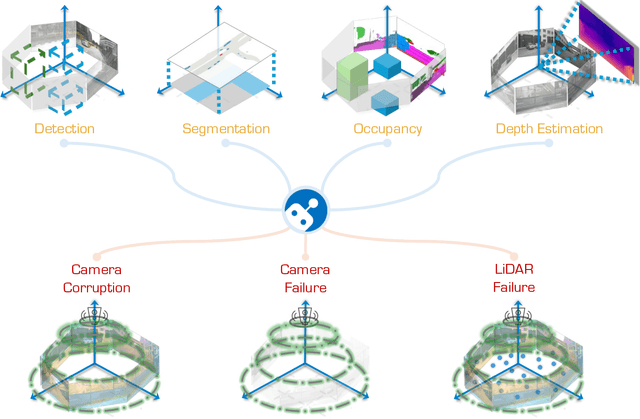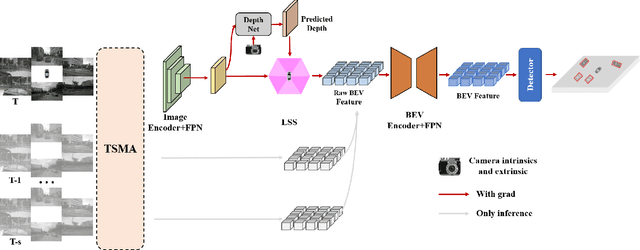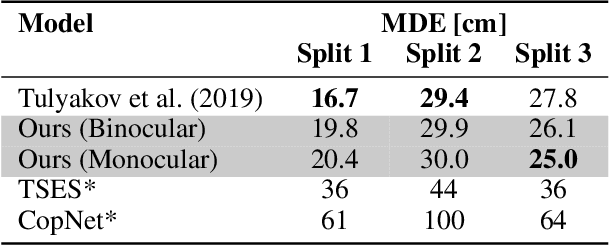Benoit R. Cottereau
EventFly: Event Camera Perception from Ground to the Sky
Mar 25, 2025Abstract:Cross-platform adaptation in event-based dense perception is crucial for deploying event cameras across diverse settings, such as vehicles, drones, and quadrupeds, each with unique motion dynamics, viewpoints, and class distributions. In this work, we introduce EventFly, a framework for robust cross-platform adaptation in event camera perception. Our approach comprises three key components: i) Event Activation Prior (EAP), which identifies high-activation regions in the target domain to minimize prediction entropy, fostering confident, domain-adaptive predictions; ii) EventBlend, a data-mixing strategy that integrates source and target event voxel grids based on EAP-driven similarity and density maps, enhancing feature alignment; and iii) EventMatch, a dual-discriminator technique that aligns features from source, target, and blended domains for better domain-invariant learning. To holistically assess cross-platform adaptation abilities, we introduce EXPo, a large-scale benchmark with diverse samples across vehicle, drone, and quadruped platforms. Extensive experiments validate our effectiveness, demonstrating substantial gains over popular adaptation methods. We hope this work can pave the way for more adaptive, high-performing event perception across diverse and complex environments.
The RoboDrive Challenge: Drive Anytime Anywhere in Any Condition
May 14, 2024



Abstract:In the realm of autonomous driving, robust perception under out-of-distribution conditions is paramount for the safe deployment of vehicles. Challenges such as adverse weather, sensor malfunctions, and environmental unpredictability can severely impact the performance of autonomous systems. The 2024 RoboDrive Challenge was crafted to propel the development of driving perception technologies that can withstand and adapt to these real-world variabilities. Focusing on four pivotal tasks -- BEV detection, map segmentation, semantic occupancy prediction, and multi-view depth estimation -- the competition laid down a gauntlet to innovate and enhance system resilience against typical and atypical disturbances. This year's challenge consisted of five distinct tracks and attracted 140 registered teams from 93 institutes across 11 countries, resulting in nearly one thousand submissions evaluated through our servers. The competition culminated in 15 top-performing solutions, which introduced a range of innovative approaches including advanced data augmentation, multi-sensor fusion, self-supervised learning for error correction, and new algorithmic strategies to enhance sensor robustness. These contributions significantly advanced the state of the art, particularly in handling sensor inconsistencies and environmental variability. Participants, through collaborative efforts, pushed the boundaries of current technologies, showcasing their potential in real-world scenarios. Extensive evaluations and analyses provided insights into the effectiveness of these solutions, highlighting key trends and successful strategies for improving the resilience of driving perception systems. This challenge has set a new benchmark in the field, providing a rich repository of techniques expected to guide future research in this field.
OpenESS: Event-based Semantic Scene Understanding with Open Vocabularies
May 08, 2024



Abstract:Event-based semantic segmentation (ESS) is a fundamental yet challenging task for event camera sensing. The difficulties in interpreting and annotating event data limit its scalability. While domain adaptation from images to event data can help to mitigate this issue, there exist data representational differences that require additional effort to resolve. In this work, for the first time, we synergize information from image, text, and event-data domains and introduce OpenESS to enable scalable ESS in an open-world, annotation-efficient manner. We achieve this goal by transferring the semantically rich CLIP knowledge from image-text pairs to event streams. To pursue better cross-modality adaptation, we propose a frame-to-event contrastive distillation and a text-to-event semantic consistency regularization. Experimental results on popular ESS benchmarks showed our approach outperforms existing methods. Notably, we achieve 53.93% and 43.31% mIoU on DDD17 and DSEC-Semantic without using either event or frame labels.
RoboDepth: Robust Out-of-Distribution Depth Estimation under Corruptions
Oct 23, 2023Abstract:Depth estimation from monocular images is pivotal for real-world visual perception systems. While current learning-based depth estimation models train and test on meticulously curated data, they often overlook out-of-distribution (OoD) situations. Yet, in practical settings -- especially safety-critical ones like autonomous driving -- common corruptions can arise. Addressing this oversight, we introduce a comprehensive robustness test suite, RoboDepth, encompassing 18 corruptions spanning three categories: i) weather and lighting conditions; ii) sensor failures and movement; and iii) data processing anomalies. We subsequently benchmark 42 depth estimation models across indoor and outdoor scenes to assess their resilience to these corruptions. Our findings underscore that, in the absence of a dedicated robustness evaluation framework, many leading depth estimation models may be susceptible to typical corruptions. We delve into design considerations for crafting more robust depth estimation models, touching upon pre-training, augmentation, modality, model capacity, and learning paradigms. We anticipate our benchmark will establish a foundational platform for advancing robust OoD depth estimation.
The RoboDepth Challenge: Methods and Advancements Towards Robust Depth Estimation
Jul 27, 2023



Abstract:Accurate depth estimation under out-of-distribution (OoD) scenarios, such as adverse weather conditions, sensor failure, and noise contamination, is desirable for safety-critical applications. Existing depth estimation systems, however, suffer inevitably from real-world corruptions and perturbations and are struggled to provide reliable depth predictions under such cases. In this paper, we summarize the winning solutions from the RoboDepth Challenge -- an academic competition designed to facilitate and advance robust OoD depth estimation. This challenge was developed based on the newly established KITTI-C and NYUDepth2-C benchmarks. We hosted two stand-alone tracks, with an emphasis on robust self-supervised and robust fully-supervised depth estimation, respectively. Out of more than two hundred participants, nine unique and top-performing solutions have appeared, with novel designs ranging from the following aspects: spatial- and frequency-domain augmentations, masked image modeling, image restoration and super-resolution, adversarial training, diffusion-based noise suppression, vision-language pre-training, learned model ensembling, and hierarchical feature enhancement. Extensive experimental analyses along with insightful observations are drawn to better understand the rationale behind each design. We hope this challenge could lay a solid foundation for future research on robust and reliable depth estimation and beyond. The datasets, competition toolkit, workshop recordings, and source code from the winning teams are publicly available on the challenge website.
StereoSpike: Depth Learning with a Spiking Neural Network
Sep 28, 2021



Abstract:Depth estimation is an important computer vision task, useful in particular for navigation in autonomous vehicles, or for object manipulation in robotics. Here we solved it using an end-to-end neuromorphic approach, combining two event-based cameras and a Spiking Neural Network (SNN) with a slightly modified U-Net-like encoder-decoder architecture, that we named StereoSpike. More specifically, we used the Multi Vehicle Stereo Event Camera Dataset (MVSEC). It provides a depth ground-truth, which was used to train StereoSpike in a supervised manner, using surrogate gradient descent. We propose a novel readout paradigm to obtain a dense analog prediction -- the depth of each pixel -- from the spikes of the decoder. We demonstrate that this architecture generalizes very well, even better than its non-spiking counterparts, leading to state-of-the-art test accuracy. To the best of our knowledge, it is the first time that such a large-scale regression problem is solved by a fully spiking network. Finally, we show that low firing rates (<10%) can be obtained via regularization, with a minimal cost in accuracy. This means that StereoSpike could be efficiently implemented on neuromorphic chips, opening the door for low power and real time embedded systems.
 Add to Chrome
Add to Chrome Add to Firefox
Add to Firefox Add to Edge
Add to Edge